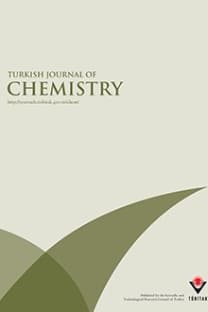Synthesis, spectroscopic characterization, and biological screening of binuclear transition metal complexes of bicompartmental Schiff bases containing indole and resorcinol moieties
Indole Schiff bases, binuclear complexes, electrochemical, antimicrobial, DNA cleavage
Synthesis, spectroscopic characterization, and biological screening of binuclear transition metal complexes of bicompartmental Schiff bases containing indole and resorcinol moieties
___
- Chavan, R. S.; More, H. N.; Bhosale, A. V. Torpical J. Pharm. Res. 2011, 10, 463–473.
- Misra, U.; Hitkari, A.; Saxena, A. K.; Gurtu, S.; Shanker, K. Eur. J. Med. Chem. 1996, 31, 629–634.
- Preeti, R.; Srivastava, V. K.; Ashok, K. Eur. J. Med. Chem. 2004, 39, 449–452.
- El-Gendy Adel, A.; Abdou Naida, A.; Sarhan El-Taher, Z.; El-Banna Hosney, A. Alexandria J. Pharma. Sci. 1993, 7, 99–103.
- Dandia, A.; Sehgal, V.; Singh, P. Indian J. Chem. 1993, 32B, 1288–1291.
- Kalgutkar, A. S.; Crews, B. C.; Saleh, S.; Prudhomnae, D.; Marnett, L. J. Bioorg. Med. Chem. 2005, 13, 6810–6822. Sureyya, O.; Dogu, N. I. L. Farmaco. 2002, 57, 677–683.
- Leneva, I. A.; Fadeeva N. I.; Fedykina, I. T. Abstract 187, In 7th International Conference on Antiviral Research, 19 Ergenc, N.; Gunay, N. S.; Demirdamar, R. Eur. J. Med. Chem. 1998, 33, 143–148.
- Louis. H. A. P.; Jacobas, P. P.; Sarel, F. M. Eur. J. Med. Chem. 2010, 45, 4458–4466.
- Merwade, A. Y.; Rajur, S. B.; Basngoudar, L. D. Indian J. Chem. 1990, 29B, 1113–1117.
- Fernandez, A. E.; Monge, V. A. Span. Pat. 400, 436. Chem Abstract 1975, 83, 1142059.
- Gangadharmath, U. B.; Revankar, V. K.; Mahale, V. B. Spectrochim. Acta. Part A. 2002, 58, 2651–2657.
- Seleem, H. S.; El-Shetary, B. A.; Khalil, S. M. E.; Mostafa, M.; Shebl, M. J. Coord. Chem. 2005, 58, 479–493.
- Shebl, M. Spectrochim. Acta. Part A. 2009, 73, 313–323.
- Liu, S. L.; Wen, C. L.; Qi, S. S.; Liang, E. X. Spectrochim. Acta. Part A. 2008, 69, 664–669.
- Taha, A. Spectrochim. Acta. Part A. 2003, 59, 1611–1620.
- Seleem, H. S.; El-Shetary, B. A.; Shebl, M. Heteroatom. Chem. 2007, 18, 100–107.
- Solomon, E. I. Pure Appl. Chem. 1983, 55, 1069–1088.
- Niederhoffer, C. E.; Tommons, J. H.; Martell, A. G. Chem. Rev. 1984, 84, 137–203.
- Jadegoud, Y.; Ijare, O. B.; Mallikarjuna, N. N.; Angandi, S. D.; Mruthyunjayaswamy, B. H. M. J. Indian Chem. Soc. 2002, 79, 921–924.
- Mruthyunjayaswamy, B. H. M.; Ijare, O. B.; Jadegoud, Y. J. Brazilian Chem. Soc. 2005, 16, 783–789.
- Mruthyunjayaswamy, B. H. M.; Jadegoud, Y.; Ijare, O. B.; Patil, S. G.; Kudari, S. M. Trans. Metal Chem. 2005, 30, 234–242.
- Rahaman, F.; Ijare, O. B.; Jadegoud, Y.; Mruthyunjayaswamy, B. H. M. J. Coord. Chem. 2009, 1, 1–11.
- Geary, W. J. Coord. Chem. Rev. 1971, 7, 81–122.
- Roy, S.; Mandal, T. N.; Das, K.; Butcher, R. J.; Rheingold, A. L.; Kar, S. K. J. Coord. Chem. 2010, 63, 2146–2157. Sulekha; Lokesh, K. G. Spectrochim. Acta. Part A. 2005, 61A, 269–272.
- Dholakiya, P. P.; Patel, M. N. Synth. React. Inorg. Metal-Org. Chem. 2002, 32, 753–762.
- Liu, H.; Wang, H.; Gao, F.; Niu, D.; Lu, Z. J. Coord. Chem. 2007, 60, 2671–2678.
- Koji, A.; Kanako, M.; Ohba, M.; Okawa, H. Inorg. Chem. 2002, 41, 4461– 4467.
- Azza, A. A. A. J. Coord. Chem. 2006, 59, 157–176.
- Mishra, A. P.; Mishra, R. K.; Shrivastava, S. P. J. Serb. Chem. Soc. 2009, 74, 523–535.
- Shriver, D. F.; Atkins, P. W.; Langford, C. H. Inorganic Chemistry, Oxford University Press: Oxford, 1990, pp. 434–468.
- Balasubramanian, S.; Krishnan, C. N. Polyhedron 1986, 5, 669–679.
- Speier, G.; Csihony, J.; Whalen, A. M.; Pierpont, C.G. Inor. Chem. 1996, 35, 3519–3524.
- Kilveson, D. J. Phys. Chem. B. 1997, 101, 8631–8634.
- Hathaway, B. J.; Billing, D. E. Coord. Chem. Rev. 1970, 5, 143–207.
- Bencini, A.; Gattechi, D. EPR of Exchange Coupled System; Springer-Verlag: Berlin, 1990.
- Bard, A. J.; Faulkner, L. R. Electrochemical Methods; 2nd ed. Wiley. New York, 2001.
- Patil, S. A.; Naik, V. H.; Kulkarni, A. D.; Badami, P. S. J. Sulphur Chem. 2010, 31, 109–121.
- Chohan, Z. H.; Arif, M.; Akhtar, M. A.; Supuran, C. T. Bioinorg. Chem. Appl. 2006, 1–13.
- Thimmaiah, K. N.; Lioyd, W. D.; Chandrappa, G. T. Inorg. Chim. Acta. 1985, 160, 81–85.
- Wahab, Z. H. A.; Mashaly, M. M.; Salman, A. A.; El-Shetary, B. A.; Faheim, A. A. Spectrochim. Acta. Part A. 2004, 60, 2861–2864.
- Meyer, B. N.; Ferrigni, N. R.; Putnam, J. E.; Jacobsen, L. B.; Nichols, D. E.; McLaughlin, J. L. Planta Med. 1982, 45, 31–34.
- Waring, M. J. Drug Action at the Molecular Level; Roberts, G. C. K. Ed, Macmillan: London, 1977.
- Vogel, A. I. A Text Book of Quantitative Inorganic Analysis; 3rd edn. Longman ELBS, London, 1968.
- Hiremath, S. P.; Mruthyunjayaswamy, B. H. M.; Purohit, M. G. Indian J. Chem. 1978, 16B, 789–792.
- Walker, R. D. Antimicrobial susceptibility testing and interpretation of results. In J. F. Prescott, J. D. Baggot & R. D. Walker, (Eds.), Antimicrobial Therapy in Veterinary Medicine. Ames, IA, Iowa State University Press. 2000. pp. 12–26.
- Sadana, A. K.; Miraza, Y.; Aneja, K. R.; Prakash, O. Eur. J. Med. Chem. 2003, 38, 533–536.
- Sambrook, J.; Fritsch, E. F.; Maniatis, T. Molecular Cloning, A Laboratory Manual ; 2nd edn. Cold Spring Harbor Laboratory, Cold Spring Harbor, New York, 1989.
- ISSN: 1300-0527
- Yayın Aralığı: 6
- Yayıncı: TÜBİTAK
Synthesis and biological activities of methylenebis-4H-1,2,4-triazole derivatives
Yıldız UYGUN, Hacer BAYRAK, Havva ÖZKAN
Orhan ACAR, Orhan Murat KALFA, Özcan YALÇINKAYA
Hülya ARSLAN, Yasemin KÜÇÜK, - Ayfer
Li-e JIN, Fenfen CHANG, Xiaojuan WANG, Qing CAO
Palladium-EDTA and palladium-EdteH4 catalyzed Heck coupling reactions in pure water
Süleyman GÜLCEMAL, Bekir ÇETİNKAYA
Jayaroopa PRABHASHANKAR, Vasanth Kumar GOVINDAPPA, Ajay Kumar KARIYAPPA
Mahendra Raj KAREKAL, Mruthyunjayaswamy BENNIKALLU HIRE MATHADA
Kaveh PARVANAK BOROUJENI, Pegah SHOJAEI
Shayessteh DADFARNIA, Ali Mohammad HAJI SHABANI, Mooud AMIRKAVEI
